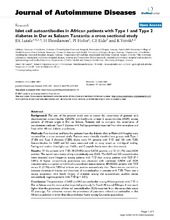Islet cell autoantibodies in African patients with Type 1 and Type 2 diabetes in Dar es Salaam Tanzania: a cross sectional study
Peer reviewed, Journal article
Permanent lenke
https://hdl.handle.net/1956/2668Utgivelsesdato
2007-10-27Metadata
Vis full innførselSamlinger
Originalversjon
https://doi.org/10.1186/1740-2557-4-4Sammendrag
Background: The aim of the present study was to assess the occurrence of glutamic acid decarboxylase autoantibodies (GADA) and insulinoma antigen 2 autoantibodies (IA2A) among patients of African origin in Dar es Salaam, Tanzania and to compare the occurrence of autoimmune mediated Type 1 diabetes with findings previously reported from the same place and from other African diabetic populations. Methods: Two hundred and forty five patients from the diabetic clinic at Muhimbili Hospital were recruited for a cross sectional study. Patients were clinically classified into groups with Type 1 (T1D) and Type 2 diabetes (T2D); there were 94 patients with T1D and 151 with T2D. Autoantibodies for GAD and IA2 were measured with an assay based on radioligand binding. Fasting and random blood glucose, HbA1c, and C-peptide levels were also determined. Results: Of the patients with T1D, 28 (29.8%) were GADA positive and 20 (21.3%) were IA2A positive. The overall occurrence of any autoantibody was 42.6%. The GAD and IA2 autoantibodies were detected more frequently among patients with T1D than among patients with T2D (P < 0.001). A higher autoantibody prevalence was observed with combined GADA and IA2A measurements compared to individual autoantibody measurements; 40 (42.6%) patients with T1D versus 11 (7.3%) with T2D had at least one positive autoantibody titer. There was no correlation between duration of disease and detection of autoantibodies in patients with T1D. There was a strong association with family history of diabetes among the autoantibody positive versus autoantibody negative patients with T1D (p < 0.01). Conclusion: The prevalence of GAD and IA2 autoantibodies among African patients with T1D in Dar es Salaam was the same as that reported previously for South Africa and Ethiopia. It was much higher than the prevalence of islet cell autoantibodies (ICA) reported from the same clinic about 15 years ago. For unknown reasons the prevalence of pancreatic related autoantibodies in this African population is lower than the prevalence found among Caucasian populations.
